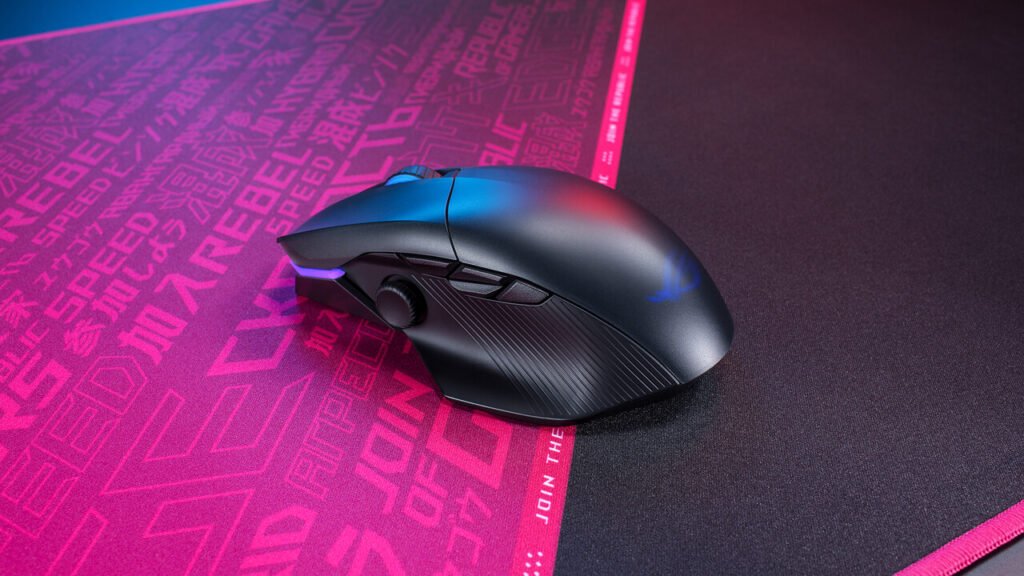Asus ROG Chakram X: All-rounder is heavy on the hand and on the wallet

With the ROG Chakram X, Asus aims to deliver a mouse that can do almost anything. The manufacturer promises precise sensors with a query rate of 8,000 Hertz, an analog stick, socket switches, a 2.4 GHz radio, Bluetooth, and a relatively long battery life. That weighs heavily – and not just in terms of price.
A brand new sensor! … or not?
To get it straight out of the way: Of course, nobody needs the 36,000 cpi Asus promises for the ROG AimPoint sensor, which was specially developed according to the manufacturer. However, the number is still interesting, as no mouse sensor has offered such a high resolution to date.
Not even PixArt’s current flagship model, the PAW-3950 in the Viper V2 Pro (test), co-developed with Razer, which comes in at an equally outdated high 30,000 cpi. The data communicated by Asus about the maximum measurable speed and acceleration – which is about 16.5 m/s and 490 m/s² respectively – again correspond exactly to the values of a PAW-3399 or PAW-3395; the maximum deviation of less than one percent is also identical. This ultimately leads to the conclusion that the ROG AimPoint is actually not a completely new Asus sensor – as the manufacturer wants to believe in its press release – but only a derivative of those two PixArt sensors.
After all, it would certainly not be the first time that a mouse manufacturer has tried to promote a unique, superior sensor system under a new name, which – due to the presumed in-house development – no other manufacturer can fall back on. It’s much more likely that PixArt re-released the PAW-3399, especially for Asus at an absurdly high resolution. Or that ROG Chakram X doesn’t natively provide the highest-resolution spectrum at all, just interpolates it.
Mechanics in the base and an analog stick on the side
But enough about the sensor, because the other specs of the ROG Chakram X also make you sit up and pay attention. Mechanical switches in Asus’ Push-Fit II socket are used as the primary button. Users can swap the magnetically fixed buttons for other 3-pin or 5-pin optomechanical microswitches at will. In addition, the mouse has five extra keys on the left side; at the bottom, there is another button to toggle through the sensor resolution sequentially. Special is the analog stick on the left, which is also replaceable. However, since most games do not offer analog mouse input, the stick can also be configured as a digital four-way button.
Image 1 of 12 Connected via the two-meter USB-A to USB-C cable, which Asus says is packaged flexibly, the USB query rate is up to 8,000 Hertz. With a wireless connection via 2.4 GHz radio, 1,000 Hertz remains, while the polling rate with an alternative Bluetooth connection – as usual – even drops to 125 Hertz. The manufacturer promises a battery life of up to 114 hours. However, it remains unclear which of the two radio modes the value refers to and the three-zone RGB lighting was active during the measurement.
ROG Chakram X is charged via cable in 15 minutes for up to 25 hours of run time, also inductive charging according to the QI standard is possible. The sensor parameters, key assignment, and RGB lighting can be customized and saved in five profiles via Asus’ Armory Crate program. These can all be found in the internal memory of the ROG Chakram X. Apart from the mouse, the input device comes with two replacement mechanical switches, an alternative analog stick, an analog stick cover, a USB adapter for the wireless dongle, a carrying case and a customizable logo for the back of the mouse.
The large package weighs twice as much
With its specs, Asus’ latest mouse is poised to become a go-to tool, but that costs elsewhere. On the one hand, the mouse with a mass of 127 grams weighs above average and is therefore complementary to the current trend. On the other hand, the suggested retail price of the ROG Chakram X is very high around 169 euros. Apart from the handmade Zaunkoenig M2K (test), no other gaming mouse is currently more expensive.
Alexia is the author at Research Snipers covering all technology news including Google, Apple, Android, Xiaomi, Huawei, Samsung News, and More.












